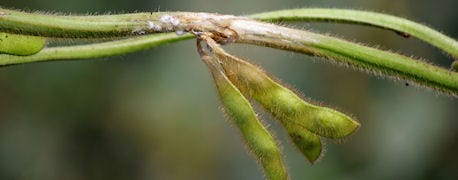July 16, 2014

By Adam Spelhaug
All the wet, humid weather recently could result in an outbreak of Sclerotinia stem rot, or white mold in soybeans.
The disease is unique in that it usually affects more productive areas of the field with better plant growth versus the root diseases that normally occur in lower and wetter soils.
Infection of plants varies from year to year and field to field. There is limited variety resistance that I have seen in my years of observing soybeans

White mold grows on a soybean plant. Photo: Michael Wunsch, NDSU
Symptoms
Sclerotia bodies are extremely hardy and are unaffected by weather and soil conditions. In fact, sclerotia from previous years can survive in the soil for over five seasons. White mold usually develops as the result of wet, cool conditions during flowering. Temperatures between 68-78 degrees F are ideal for spreading the disease. If the soil surface remains wet for at least 10 days, the sclerotia bodies will germinate and develop spores that infect the plants. Symptoms may not be visible for up to four weeks after infection. At this time, gray or white lesions form on the stems, and the leaves above the infection point will eventually wilt and die. Pod fill will be set back, and infected plants may not produce any seed. Yield loss can be greater than 15 bushels per acre in the most severe spots of the field. Soybean standability and seed quality may both be reduced. If the plant is flowering and the environmental conditions are right, the soybean has a chance of being infected.
Management
Managing white mold is difficult once the disease is present in the soil. By the time white mold is visible in the field, it is too late for fungicide application. Preventative measures are the most effective treatments; a fungicide application at the early bloom stage (R2) has shown some benefits in area research trials.
Trials conducted at North Dakota State University's Research Extension Center near Carrington, N.D., have shown limited success with white mold prevention. In these trials, Endura fungicide is the only treatment that has been significantly successful in managing white mold. The treatment consisted of an application of 5.5 ounces per acre of Endura, followed by 4 ounces per acre of Priaxor, with a cost about $38 per acre. While effective, it is a high input cost to control a problem that may not be present. The trial near Carrington showed a 13 bushel per acre response to this treatment, so return on investment was very positive in this case.
Endura + Priaxor would be a good application in fields that have a tight rotation with dry beans, canola, sunflowers or soybeans, as well as fields with a history of white mold. An application of 6 ounces per acre of Cobra has shown mixed results for reducing white mold. Valent claims the Cobra stimulates the soybean to produce natural defenses to ward off infection of Sclerotinia.
If you're looking to try a fungicide to prevent white mold this year, consider using one with either a 7 (Endura) or 11 (strobilurins) Site of Action, applied at the early flower stage. This has been the best treatment in recent trial work. Remember, applying fungicide after infection will not cure the plant of white mold.
If you discover white mold on your farm, follow these harvest tips:
Harvest healthy fields before harvesting disease-infested fields, if possible, so the combine does not transport sclerotia to other fields.
Be sure to thoroughly clean out the combine at the end of the season.
After a cool, wet spring, conditions in our region are ideal for white mold growth. As you scout, remember that "you can't judge a book by its cover." Make an effort to monitor all of your fields and check under the canopy for evidence of white mold. Continue to adapt your practices to prevent potential yield loss. This is especially important if you have a history of white mold on your farm.
Spelhaug is an agronomist with Peterson Farms Seed, Harwood, N.D. Follow him on Twitter at @PFSAdam, and read his contributions to The Peterson Blog at www.petersonfarmsseed.com/blog. For more information, contact him at 866-481-7333 or [email protected].
You May Also Like




